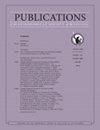An Automated Catalog of Long Period Variables using Infrared Lightcurves from Palomar Gattini-IR
IF 7.7
3区 物理与天体物理
Q2 ASTRONOMY & ASTROPHYSICS
Publications of the Astronomical Society of the Pacific
Pub Date : 2024-08-20
DOI:10.1088/1538-3873/ad68a4
引用次数: 0
Abstract
Long Period Variables (LPVs) are stars with periods of several hundred days, representing the late, dust-enshrouded phase of stellar evolution in low to intermediate mass stars. In this paper, we present a catalog of 154,755 LPVs using near-IR lightcurves from the Palomar Gattini-IR (PGIR) survey. PGIR has been surveying the entire accessible northern sky (利用帕洛玛-加蒂尼-红外光谱的红外光曲线自动编制长周期变星表
长周期变星(LPVs)是指周期长达几百天的恒星,代表了中低质量恒星演化后期的尘埃笼罩阶段。本文利用 Palomar Gattini-IR(PGIR)巡天观测的近红外光曲线,给出了一份包含 154755 个 LPV 的星表。自2018年9月以来,PGIR一直以2-3天一次的频率在J波段对整个可进入的北部天空(δ >-28°)进行巡天,目前已经产生了6000多万个源的J波段光曲线。我们使用梯度提升决策树分类器,在从 PGIR 光曲线提取的综合特征集上进行训练,以搜索该数据集中的 LPV。我们开发了一套并行化的优化代码,以每条光曲线 ∼ 0.1 秒的速度提取特征。我们的模型可以成功地将 LPV 与其他恒星区分开来,真阳性率高达 95%。通过与已知 LPV 的交叉匹配,我们在星表中发现了 70,369 个(46%)新的 LPV。
本文章由计算机程序翻译,如有差异,请以英文原文为准。
求助全文
约1分钟内获得全文
求助全文
来源期刊
CiteScore
6.70
自引率
5.70%
发文量
103
审稿时长
4-8 weeks
期刊介绍:
The Publications of the Astronomical Society of the Pacific (PASP), the technical journal of the Astronomical Society of the Pacific (ASP), has been published regularly since 1889, and is an integral part of the ASP''s mission to advance the science of astronomy and disseminate astronomical information. The journal provides an outlet for astronomical results of a scientific nature and serves to keep readers in touch with current astronomical research. It contains refereed research and instrumentation articles, invited and contributed reviews, tutorials, and dissertation summaries.

 求助内容:
求助内容: 应助结果提醒方式:
应助结果提醒方式:


